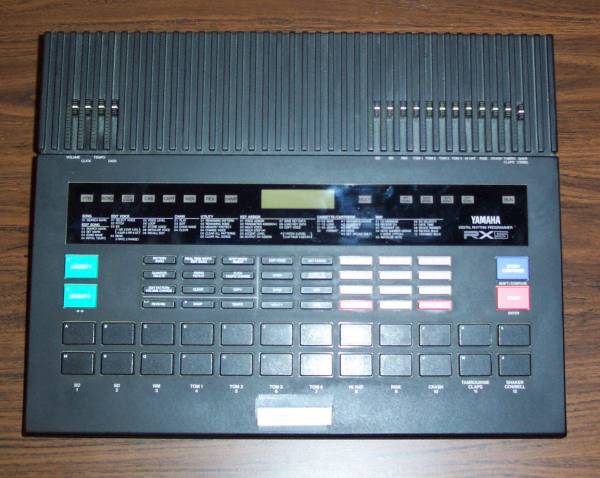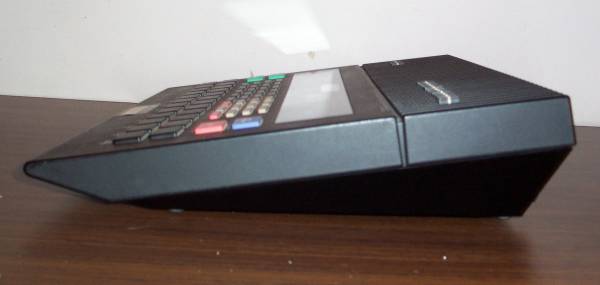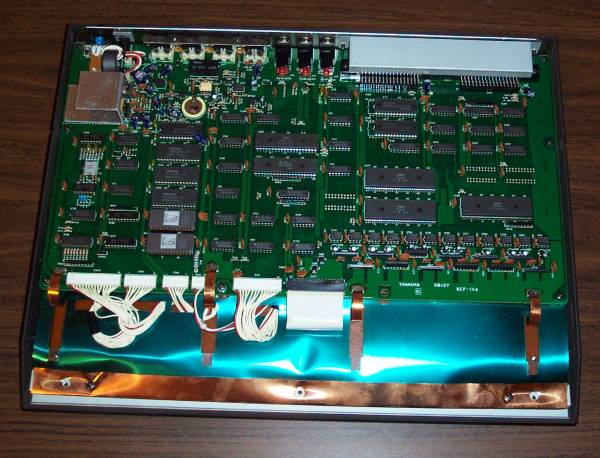Yamaha RX5- Owned from August 2000-present, bought for $200 with all Yamaha-produced sound cartridges.
The RX5 was Yamaha's flagship drum machine, and the best drum machine around until the Roland R8 came out, introduced around 1986 for something like $1200. It was reasonably popular in its day but now is pretty obscure and cheap, I guess because people either go for simpler machines like the Alesis SR-16 or the overhyped Roland boxes. The RX5 doesn't get the credit it deserves, but this also means it's a very good buy.
The RX5 is a very powerful machine, similar to the R8 but without the human feel function or velocity-sensitive pads. In my mind though, the overall sound makes this a better (or at least more interesting) machine than the R8.
Physically, it's a rather odd looking (wedge-shaped like most 80's Yamaha gear) and very well-constructed drum machine. There are 24 pads corresponding to internal sounds, with volume sliders and outputs corresponding to each pair of pads. Other than that, stereo outputs, headphone jack, click input, foot pedal, midi, and slots for a sound cartridge and RAM cartridge. There is a backlit 2x16 LCD display and a row of lights that indicate modes. Menu functions are shown on a chart.
Each pair of pads is monophonic and has its own output, with a fixed panning position in the stereo outputs. This is rather limiting but intentionally using the sounds to cut each other off give interesting effects.
The unedited internal sounds of the RX5 aren't anything to get excited about, just average 80's sounding 12-bit drum samples. The cartridges make things a bit more interesting. One cartridge comes with the RX5 and contains a few miscellaneous additional sounds, ethnic drums, a few DX7 samples, and some James Brown vocal samples (yes, I'm serious). There are also 3 optional cartridges, WRC02, WRC03, and WRC04. The "Heavy Metal" cartridge (WRC02) contains boring rock drums and guitar samples. The "Jazz" cartridge (WRC03) has some very nice acoustic drums, and the "Sound Effects" cartridge (WRC04) has noisy FM industrial style sounds. Of these, the standard cartridge has a few good sounds, and the Jazz and Sound Effects cartridges are pretty good, but just listening to the sounds, the RX5 doesn't seem all that great. It's the voice edit and key assign menus, plus the sequencer, that really make the RX5 a great drum machine. There were also supposedly cartridges produced by Sound Source Unlimited with TR-808 samples and things like that, but I've never seen any.
In the voice editing menu, the sounds can be tuned up 2 octaves or down 3. There is a nice envelope and autobend, and the sounds can be set to either loop or play once and stop. This may not sound like much at first but it can mangle sounds pretty well: tuning a sound down makes it take on a whole new character, and changing a few of the parameters can make a sound completely different. With the cartridges the RX5 is now capable of a very wide range of sounds, particularly industrial/IDM sounds. The key assign menu does the expected functions of assigning sounds to keys but also in this menu the sounds can be edited as well. This seems a bit redundant at first but it actually means that by using this menu while recording patterns, drum sounds can be edited differently for each pattern. Also in this menu is a rather useless "multi voice" mode where one sound is assigned to a group of 12 pads (though still monophonic) and parameters such as pitch, amplitude, decay, etc. can be set to change across the range of keys. In this menu it is also possible to set two accent keys- they can only affect amplitude but they can affect each sound a different amount and can affect all of the instruments individually (unlike on the TR-808 where all sounds are accented at once). Finally, all of the key assign settings can be saved into 3 "drumkits". I find this useful for controlling external devices- one drumkit stores settings for using internal sounds and the other stores settings for using midi.
The sequencer offers the typical real time and step writing modes. Sequences can have any length or time signature. Quantize and metronome can be set from 1/2 notes to 1/64th note triplets. Swing can only be used when quantize is set to 1/8th or 1/16th notes and has 5 selectable values. Pretty standard stuff, but there are also "damp" and "reverse" buttons. The "damp" button puts a sound into its release phase. And it gets really interesting in the edit pattern mode, where the pitch, amplitude, attack, and decay of each sound can be edited for each step. Editing in this mode is not fun or easy but it is extremely versitile. In song mode there can be neat things like nested loops and tempo changes. Songs can even be chained, though I've never used this feature.
The sounds and sequences can be stored on a RAM4 cartridge, dumped to tape, or transmitted as sysex data.
There is also an interesting trick that can be done to get more sounds. This may just be possible on my OS version (I don't have the latest). In the key assign menu there is a "voice copy" function that puts a sound (internal or cartridge) into any of 12 copied sounds (one for each channel) so that multiple edits of a sound can be used at the same time. At first I thought this actually copied sounds from a cartridge into RAM, so I copied sounds off of one cartridge and put in another. The copied sounds were now bursts of noise, low sine wave tones, partial drum sounds, etc. Obviously, copied sounds just point to where the data is on a cartridge, and changing the cartridge means the sounds point to the wrong data. This adds an interesting new dimension to the sounds of the RX5, and while the results aren't always useful, they're often very interesting.
There are several hidden key combinations which are listed in the manual:
Holding the Accent 1 button on power-up will load the (really funny) demo song.
Inside, the RX5 is very well built. The CPU is a Hitachi HD63B09. There are four cusom VLSIs- a YM3802, 2x YM3907, and a YM3908. Presumably the 3907 and 3908 generate the sound. There are also 12 Y3014B serial DACs, one for each channel. This shows that the RX5 uses the older method of using multiple DACs with variable sample rates to generate different pitches, rather than a single DAC running at a fixed rate with DSP-based resampling and interpolation to change pitches. The result of this is that there is no aliasing when samples are transposed up, and that they sound grainer when transposed down because there's no interpolation to smooth out the waveform. This is part of why I think the RX5 sounds so nice.
Overall the RX5 is a very good drum machine with a nice punchy sound. I think it is useful mostly for artificial electronic sounds because there are much better drum machines for acoustic sounds.
A couple of years after the RX5, Yamaha released the RX7, which is similar in concept but has updated features. This machine has no sound cartridge port, but has 100 internal sounds (I assume most of these are taken from the RX5 cartridges). It only has stereo outputs and there are no sliders to control the levels of each sound, but panning can be edited for each sound. The envelopes are simplified somewhat, and there is no reverse button, but there is an "effect" button in its place, which enables up to 4 copies of a sound to be played, each with variable delay, pitch, panning, and volume. Each sound can be played with variable polyphony, from 1 to 8 (no more fixed monophonic channels). Also, the RX7 adds pitch and amplitude LFOs (!). This sounds good, but it also means that the RX7 probably doesn't have the same DAC setup- I haven't heard the RX7 but I wouldn't be surprised if it sounded a lot cleaner.
pictures:





sounds:
RX5-1- quick demo showing off some of the sounds obtained from sound copy glitches
links:
Yamaha has user manuals for nearly all of their products available here: Yamaha Manual Library (English)
back to synth index